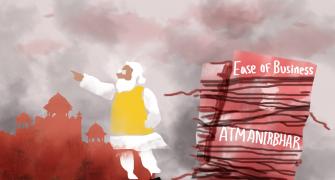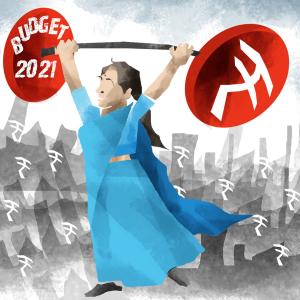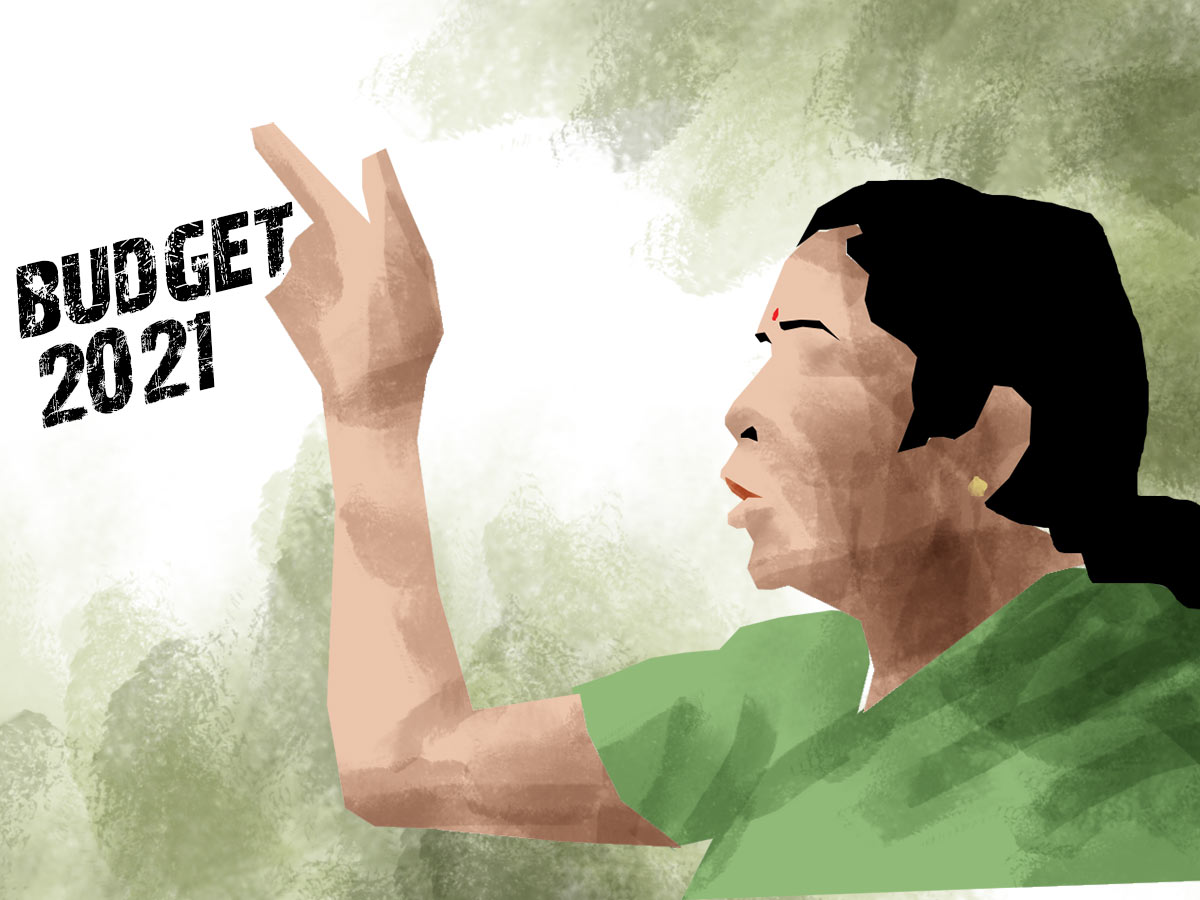But it is disappointing to note that Sitharaman's third Union Budget continues to promote a few problematic ideas, observes A K Bhattacharya.

All the past Union Budgets presented by finance ministers of India after a year of contraction in gross domestic product, or GDP, were singularly devoid of any major taxation proposals.
In her Budget for 2021-2022, also presented after a year of GDP contraction, Finance Minister Nirmala Sitharaman has broadly followed that tradition set by her predecessors in the area of taxation, but in many other respects, she has outdone them.
Barring the promise of a customs duty rationalisation, some increases and reductions in import tariffs to help the domestic industry and simplification of direct tax procedures for individuals, the rates of other taxes have remained by and large unchanged.
Of course, this exercise has triggered apprehensions of protectionism and some uncertainty has been caused by the promise of reviewing the current duty exemptions for over 400 items.
Note that customs revenue next year will account for just about 6 per cent of the Union government's gross tax collections, which at Rs 22 trillion are expected to increase by about 17 per cent over the revised estimate for 2020-2021.
If the nominal GDP grows by 14.4 per cent next year, a projected tax increase of 17 per cent implies a buoyancy of 1.2.
This may be an ambitious task, but it is not entirely unfeasible given that there are no tax giveaways in the Budget, the direct tax base has not been narrowed and the estimate for excise duty collections is quite modest, showing a 7 per cent decline over the 2020-2021 figure of Rs 3.61 trillion.
Perhaps, the government has already built into the lower number the possible impact of a rollback of excise duties on oil products, which were steeply raised in April-May 2020.
The excise increase in two instalments had helped the Centre register a 50 per cent increase in its excise revenue in 2020-2021, over the total collections of Rs 2.4 trillion in 2019-20.
The bulk of the revenue under excise is accounted for by petroleum products.
This may well provide some cushion to government revenues next year, if international crude oil prices were to remain stable and there was no pressure on the finance ministry to reduce the excise duty on petrol and diesel, in particular.
It is also significant to note how Sitharaman has departed from her predecessors presenting a post-contraction Budget.
All of them -- Jawaharlal Nehru in 1958, Sachindra Chaudhuri in 1966, Yashwantrao Chavan in 1973 and R Venkataraman in 1980 -- had refrained from making any major or bold moves on policy. But unlike them, she has embarked on at least four new initiatives in her Budget for 2021-2022.
One, she has made the Budget numbers on fiscal deficit more transparent by reducing the off-Budget borrowings substantially in 2020-2021 to Rs 1.26 trillion and proposing to slash it further to just Rs 30,000 crore in the coming year.
Indeed, it is this attempt at greater transparency which has contributed to the bloating of the fiscal deficit to 9.5 per cent of GDP in the current year.
This process to achieve greater transparency is to be continued next year, which means that the loans from the National Small Savings Fund would not be used at all to finance the food subsidy bill in 2021-2022. Also, this implies that the quality of the fiscal deficit would be less problematic.
Two, the 26 per cent increase in the government's capital expenditure at Rs 5.54 trillion next year, over a 31 per cent increase in 2020-21, reflects the finance minister's continued commitment to spend more under this head.
The increase in the absorptive capacity of the ministry to spend more under capital expenditure is also notable. Against Rs 4.12 trillion budgeted under this head in the current year, the revised estimate places the figure at Rs 4.4 trillion.
This, however, means that the squeeze on the government's revenue expenditure has been unprecedented in recent times.
Revenue expenditure in the coming year would decline by 3 per cent over Rs 30 trillion in the current year.
If you exclude the interest payment liability, the decrease in the government's revenue spend on various programmes in the coming year will have actually gone down by 9 per cent.
Those who were expecting a stimulus package through higher revenue expenditure in the Budget will surely be deeply disappointed.
Three, there has been no attempt at nibbling at the direct taxation base. No tinkering with tax slabs or raising the exemption level for individuals.
Taken together with the creation of a tax dispute settlement committee and the promise of not reopening tax cases of more than three years, where the tax evasion claim is less than Rs 50 lakh, these measures should improve the confidence of taxpayers in the tax administration.
Four, Sitharaman's Budget has a series of bold announcements and new schemes that were long overdue.
These include the government's decision to allow foreign direct investment in insurance companies up to 74 per cent, privatising two public sector banks and an insurance company, a new policy on the strategic sale of public sector undertakings, monetisation of assets in a host of infrastructure sectors, decriminalisation of laws pertaining to limited liability partnerships and the creation of an institutional framework to ensure expeditious implementation of projects under the National Infrastructure Pipeline.
Against the backdrop of all these major policy initiatives, whose implementation would raise many questions and pose many more challenges given the government's past record in this area, it is disappointing to note that Sitharaman's third Union Budget continues to promote a few problematic ideas.
The proposal to set up a bad bank, whatever nomenclature one may give it, in the current context of the financial sector's stress level is a bad idea.
The move to create a new developmental financial institution may not address the real challenges of providing funds to the infrastructure sector.
Precious resources of the government may be used to finance projects that may pass muster politically, but not pass the tests of financial viability.
Worse, the states have once again reasons to complain. While the Centre will reduce its fiscal deficit to 4.5 per cent of GDP by 2025-2026, the states have been given a tougher target of returning to the level of 3 per cent of GDP by 2023-2024. But the Centre may well argue in its defence by saying that this is what the Fifteenth Finance Commission had recommended!
Feature Presentation: Rajesh Alva/Rediff.com










